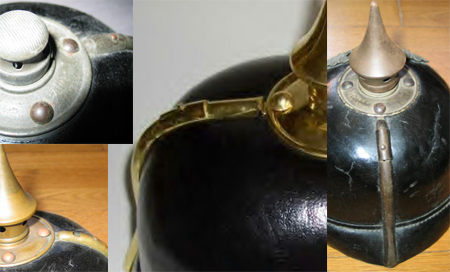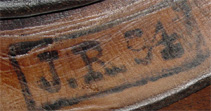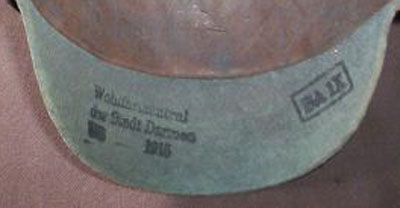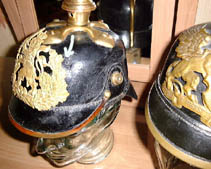Pickelhaube Fakes and Doctor Jobs
Joseph P. Robinson
22 Nov. 2007
We have all seen our share of questionable items. But how can I be sure? This is a tough one that all collectors sweat over. The guys who collect medals have bunches of fakes they have found. It makes my head hurt. It is a full time job with one or two truly trusted dealers. Pickelhaubes are starting to do the same. More forgeries, fakes and attempts to alter helmets to increase value. I was spurred to do so when I saw a helmet (OR Brunswick) go for over $2200. 100% of the people who wrote me claimed it was phony. It is necessary to get a black light. The black light test is not fool proof but it is a clue. The idea is that modern fabrics and paint will glow under a black light. Something to do with the chemicals used in production. So I though I would ramble about things I have found. Remember I only offer opinion so I might be wrong. If you have anything to send please do and I’ll try to add it.
Depot marks
| Clothing collectors have been fighting inked markings for a while. This on the left is a suspect depot mark. 1. Seems too small
2. The ink is perfect. 3. As one collector said “I don’t like Times New Roman Font on Pickelhaubes.” The easy focus is on the #9. Look at the suspect 9 and the one on the right or at the example in Lacarde Vol. 1 page 154. What would a black light show? We have a large article on depot marks at:
|
Unfortunately the fakes in felt helmets are getting pretty good. Be careful of marks that look like this. The real check is to see right off if the helmet in question could have been in IX Corps. This helmet and one other with the faux markings revered could not have been in IX Corps.
|
Galvano Copies
I know little of the metallurgy required in pickelhaubes. We will see wappen later in the article, but you often hear about galvano copies. Well here is a comparison. Not as easy as I thought to pick out from the front. What is important is to remember how plates were made in those days. A male and female half stamped together. So the detail on both front and back should be just as crisp. These pictures from the Braziel collection
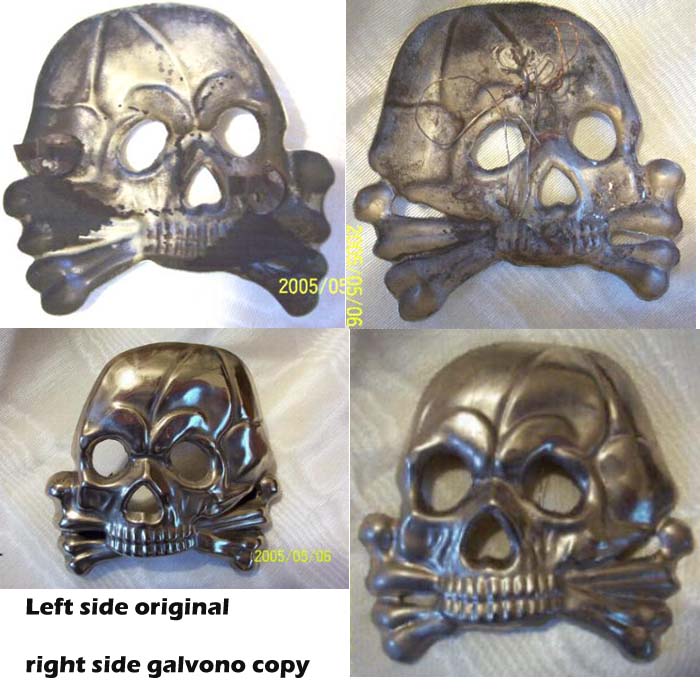
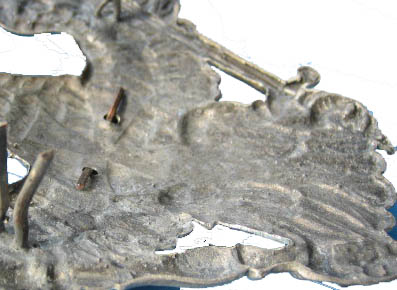
The 162nd and other Hansiatic cockardes.
I have seen too many of these. Pop off the Prussian and pop on the repro. Dig the repro cockade in your garden for a week and claim the helmet came from your grandfather in Hamburg. Charge huge money and some soul will buy it. They are after all very rare. The ONLY difference between a Hamburg Officer and a Prussian Officer is the cockade. If you see anything close to such a cockade be careful. For OR helmets the helmet must be depot marked to the Hansiatic regiment or you are buying a problem. It is instructive that even Saunders in his wonderful collection only has an OR 83rd. The landwehr cross for these regiments is distinct. So finding a landwehr helmet is a more sure bet. The cross has a different motto on it. Instead of the standard 25 mm line cross, the Hansiatic reserve cross only has the motto ‘mitt Gott Furs Vaterland” as they had a Bürgermeister, not a royal prince or titular head. Finding the correct reserve cross to add to a helmet in this case would be much much harder than finding a cockade. No I’m not stupid enough to believe that all Hansiatic helmets have the correct cross on them, but it is an additional clue.
Repro Helmets
Catalog Frankonia and others sell repro helmets complete as repros. Problem is folks turn around and sell them as original. Most of these helmets are very good but have mistakes. Recently I have seen a 2nd Gd. Uhlan “Officer” complete from Frankonia offered from Grandpa’s closet. Flat chin scales, OR Guard star, and wrong corps markings, non-officer field badge (not OR either) and OR brim. Still people bid on it. Others I have seen include a Non-voided line officer from Prussia, Hesse, Bavaria, Wurttemberg, Baden, same as above with ball. A pretty good Saxon OR arty and a series of shakos. Full helmets are mostly officer with very bright fixtures. Brass not gilt.
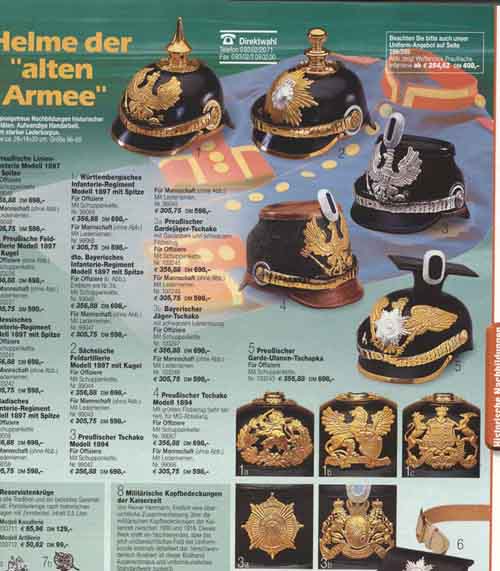
Great Wars Militaria and I’m sure others do a service to the reenactor community and sell a great deal of reproduced helmets. They custom make helmets even officer ones. They are very straight forward about what you are getting. Again the trouble comes from others selling a reproduction as real and duping a collector. Let us compare a few items. Liners can be very easy. Something to alwasys look out for is a very long machine bolt connecting the rear spine.Long bolts are normally a bad sign.

A large space between the helmet base and the vent device is another tell tale. Here are some originals and the one in the middle is a reproduction….too far away from the base. Originals from the Chen collection.
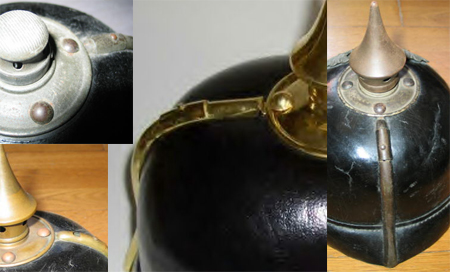
Look at the dome studs. Originals were pretty flat. Reproductions often have tall, big stud tops.The spike in the center top is a reproduction.
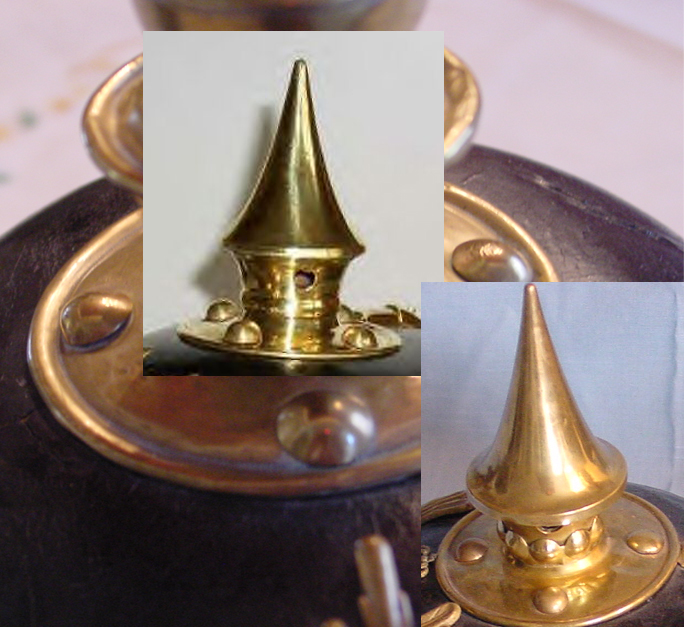
Repro Parts
The easiest and most used item is the chinstrap on OR helmets. Regularly easy to spot. This leather, smooth looks and feels brand new. Sold as repros but you see tons of eBay helmets with repro straps sold as original. If the leather straps were identical to the M16 steel helmet straps it made sense that these were transferred and the cockardes went missing. Many cockardes are repros. I have not been able to always tell which is which. Whole assembly’s are now being reproduced. Look at the spike and supports below newly minted. The repro Arty spike for the M15 is cool and comes with rust!
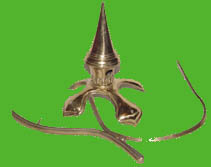

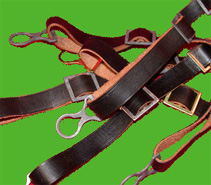
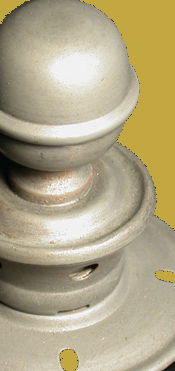
Gromets
The problem here is putting brass parts on a grey M15 helmet. The final tell tale sign is the grommet holes for the helmet plate. Brass on brass good. Grey on brass good. Brass on gray bad in almost all cases.

Its a One Year Volunteer (OYV) Helmet.
Read the article on OYV’s in this section. This is the biggest area of doctor jobs in the industry. Compare the article to dealer write-ups.
Dealer write ups.
Even paranoid people have enemies. Most — not all US based dealers I have seen make bad mistakes. Some are honest mistakes. Some are just trying to make a living by cheating folks. Be careful. Rate the item not the write up or the dealer’s reputation. I have been looked in the eye by a MAX certified dealer and one in England who clearly had doctor jobs. They refused to admit it. The good news is since our articles have started many many dealers and eBay sellers have changed their write-ups and added pictures of depot marks and the rear of plates. We flatter ourselves by believing that we had an impact but in general the level of informed collectors has risen through this and other sites as well as forums.
Double Holes and Doctor Jobs — look at this Hessian (next 2 photos from the Francom collection)
| We all know of double holes. Sort of. Many helmets have double holes or Döppellocher as new plates are added to old leather. So if I have an old helmet and a more valuable plate I marry them together and I make money. As there were hundreds of wappen makers the sizes varied for the placement holes. The very worst I have seen is the Hessian to the right that has double holes punched for a Prussian East-West eagle. Now new plates were added as helmets and went to Landwehr duty or switched regiments. For OR helmets ALWAYS make sure the markings match up. For Officer’s make sure the old holes are professionally filled. Pickelhaube dealers offered a refit service based on the huge price of the haube. |
|
Repro Plates
| Yes Dorothy there are phony plates. Normally called galvano copies these were molded using the galvano method. Less detailed with bubbly backs. A senior collector told me that there were actually inexpensive galvano plates made in period so patina becomes something. Look at the plate below and compare detail and patina with other brass parts. Looks funny don’t you think?
|
The next set of pictures shows a plate post and back made in Poland (with Permission) Look at the bubbles and smooth transition on the post. A couple of thoughts here.
1. Look for old gun metal colored solder. The posts or loops were not part of the plate and if you don’t see old solder something is wrong. Old solder came in globs. Not clean and easy to spot. Painted solder is bad.
2. Old plates were stamped new ones cast. So there is little detail on the back of the new ones.
3. If the finish of an officer’s plate is bright and polished wave off.
These pictures provided by an eBay seller.

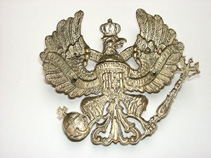
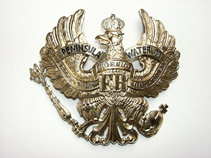
The plates below have all been properly advertised as reproductions.
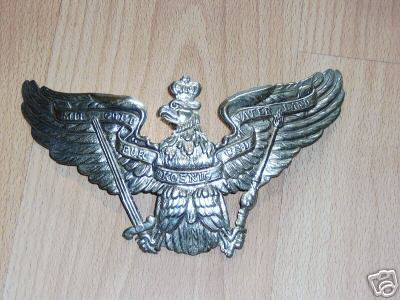

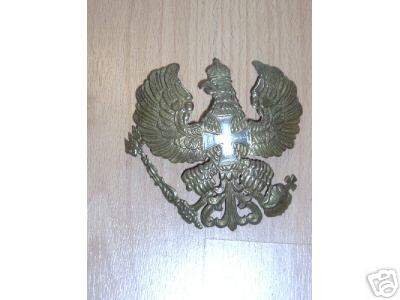
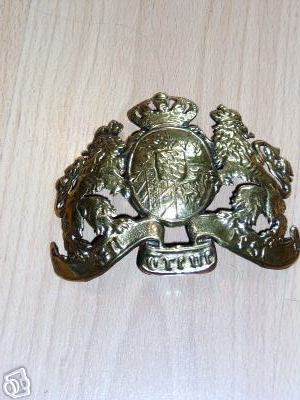
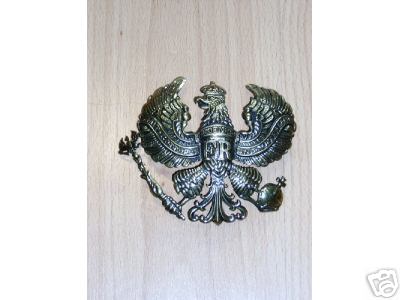
Liner
Look at the sloppy sewing job around the edge of the liner. You can see the machine sewing job as a dark line on the leather.
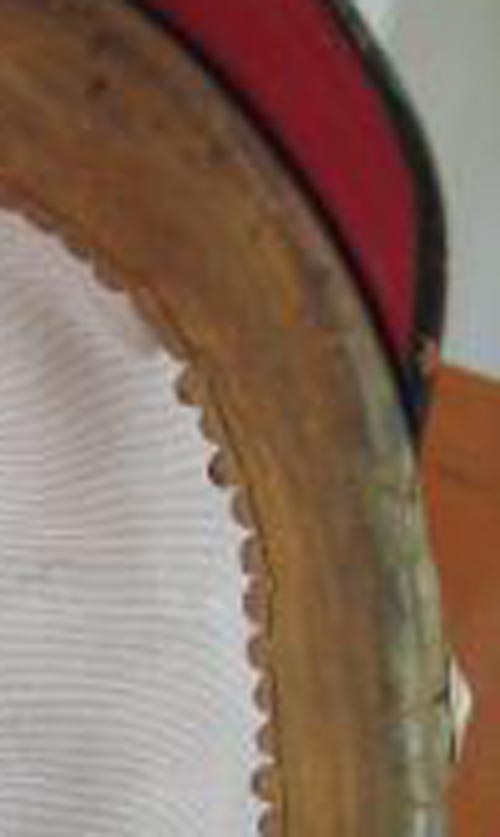
Fake Felt
Lots of fakes here. There is even a web site that tells you how to make a felt spiked helmet. A collector friend’s husband visited a factory in England where felt helmets were being made in the 1970s. There were also some fakes that came in through the Eastern bloc. Those were allegedly squishy. The standard filzhelme is quite hard. Most of the metal fittings look old or are old. There are even reportedly very good stamps of depot marks on the back of these helmets. Frequently they are non-sensical, marked to a Saxon in X Corps for instance. Frequently these depot marks are very clear and brightl. A black-light can work wonders on the threads of the liner. New thread will glow. Many fakes have a leather edge that goes all the way around. These are regularly light in color. I call them the chocolate colored trim. These pictures represent a modern trim and a helmet made to trick. Good example of a fake. Leather trim all around….. I know of no original made of Fliz. (Cork sometimes, very dark trim.) These pictures from the Booth collection.
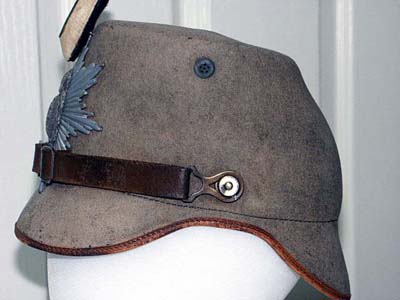 |
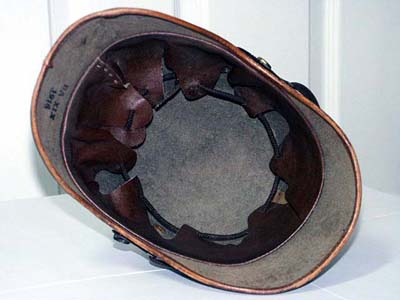 |
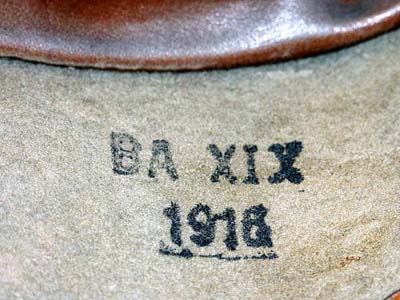
Odd Wappen
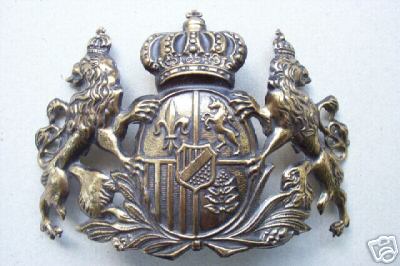
You have to be careful of wappen that you find that are not in reference books. The wappen above looks like a Bavarian wappen at first glance. But the excitement of finding a new, unknown wappen, has to be tempered by the discovery that this is actually a modern device used on a box of cookies.
Labels from Makers
These are getting very convincing. They have been often copied and used to cover holes and other sins. Look at the font! This example with tea soaked in the label might convince but is misspelled!

|
The R22 Helmet |
|
|
One of the most frequently encountered fakes is the famous R22 helmet. Also known as a scroll helmet these are discussed in some detail at: http://www.pickelhauben.net/articles/Scroll_helmets.html Johansson has an example of R22 helmet in his book “Pickelhauben” on page 60. It is a filz helmet with a ventilated spike base and a scroll with cut out letters. He calls the metal “pewter”, and states that the R22 designation stands for Infantry Regiment 22. There is no visor trim. It has a black leather chinstrap with gray metal buckles. This was obviously a rare example and if you could fake it you might be able to make a tidy profit and explain away some anomalies in the helmet as a rare variant. While often faked these have changed over time. Due to largess and humility of certain collectors we have two examples here that are 30 or 40-year-old fakes. Trawnik found these in an old collection and is sharing them with the community to help educate others to stay away from such tripe. It may be instructive to see how these were done. |
|
 |
|
|
The word on the street was that these fake helmets came from two sources – one from Great Britain and the other from Eastern Europe. I believe these two examples are from Great Britain. Let’s look at the first one. |
|
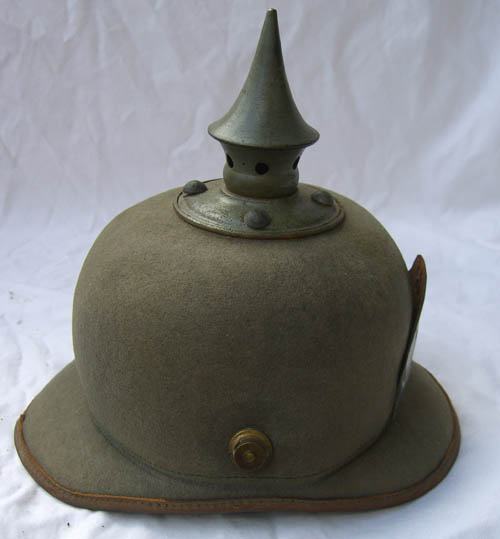 |
|
|
An oddly shaped filz helmet. A very rounded top with a leather trim all the way around. A gray metal spike and a brass M91 post. The gray metal items are magnetic. The Wappen is not flush to the helmet body. The round studs used to apply the spike based to the helmet body are very large. The spike base itself is unusual and the spike does not twist off like a normal M15. There is some sort of lacquer on the spike and spike base and the two pieces are quite static. |
|
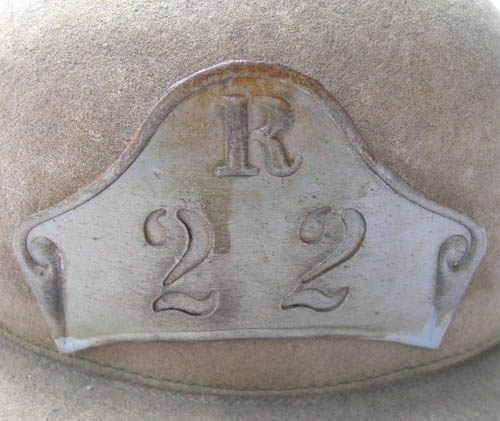 |
|
|
The Wappen appears crude. The letter “R” is embossed and you can see how it was pushed up from the back of the plate. The number “22” is recessed into the plate and you can also see on the back where it is pressed in. |
|
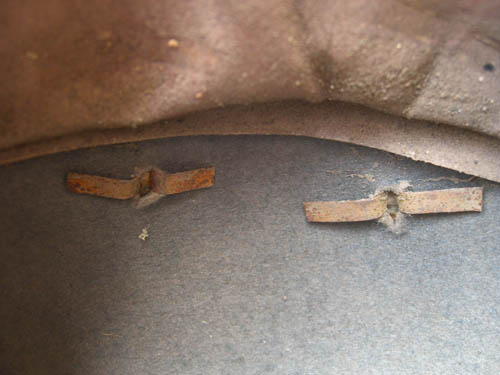 |
|
|
The Wappen is attached to the helmet through the use of metal prongs. These are set very low and resulted in the top of the Wappen not being flush against the helmet body. These prongs are metal. There are no grommets. |
|
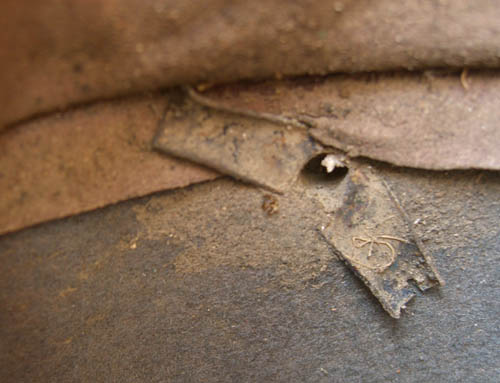 |
|
|
The M91 posts are attached with these metal prongs.
|
|
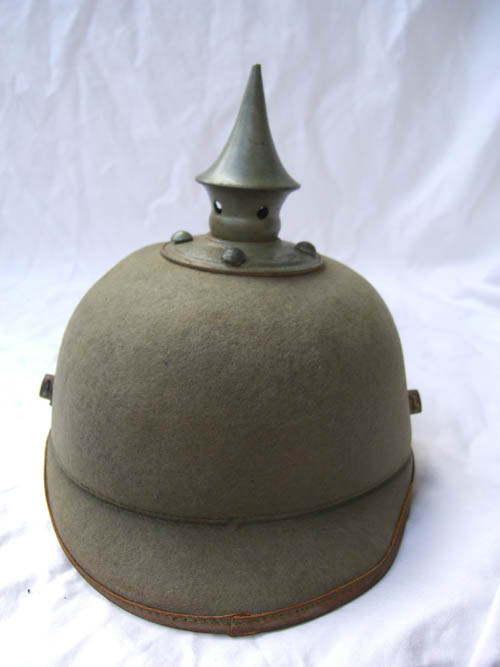 |
|
|
There is no spine on the back of the helmet. |
|
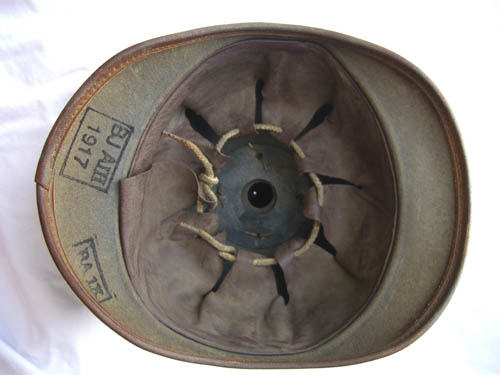 |
|
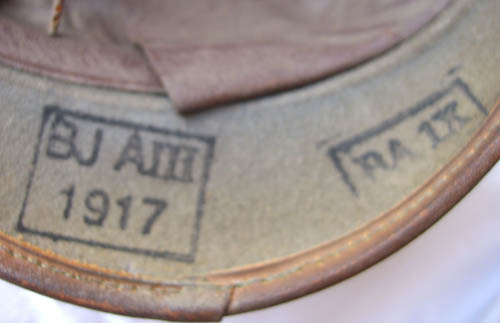 |
|
|
There are a series of faked marks on the rear visor. It is instructive to the collector that both the corps assignments as well as the typeset or font are dead giveaways of the non-originality of this piece. |
|
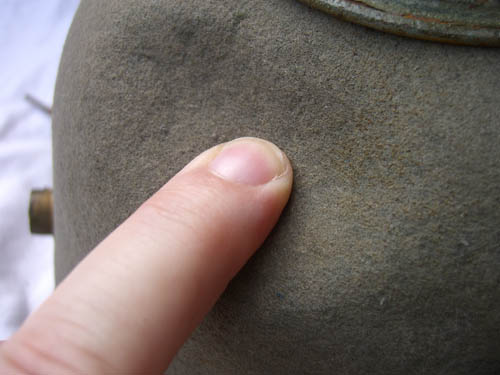 |
|
|
Known to be “squishy” this finger pressure should show a lack of rigidity of the helmet shell. The second helmet has many of the same characteristics but appears to be later production. The Wappen has deteriorated in detail significantly. The reproduction process has taken its toll as you can see by this example. |
|
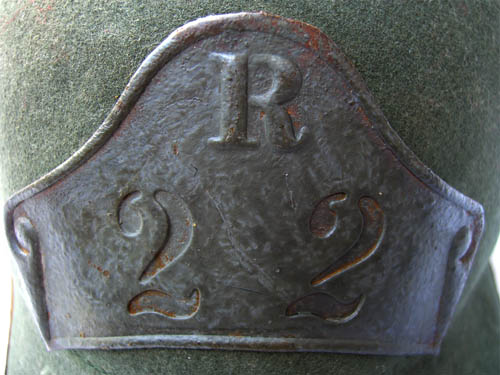 |
|
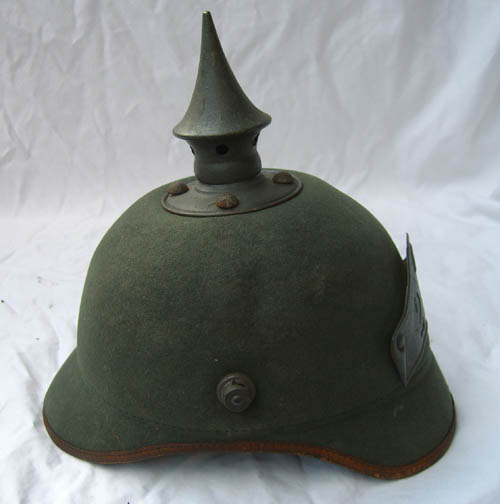 |
|
|
The material of the helmet is darker in color, all metal parts are a gray metal. The spike is still static and the Wappen still has a lean. |
|
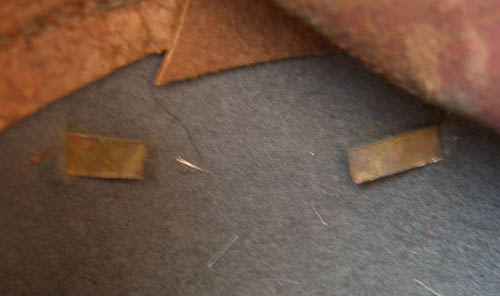 |
|
|
The method of attachment has changed with only one prong per side and this is placed into a slit instead of a larger hole. |
|
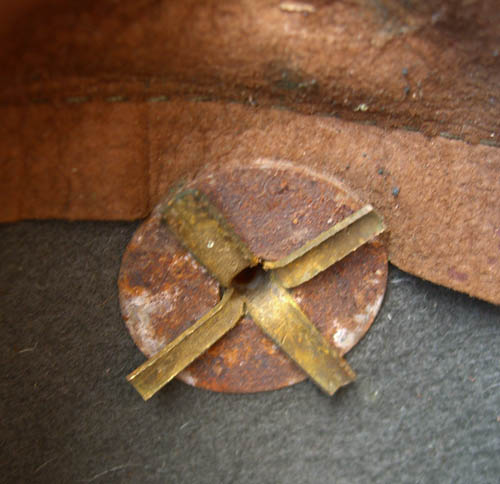 |
|
|
The M91 posts are attached in this way. |
|
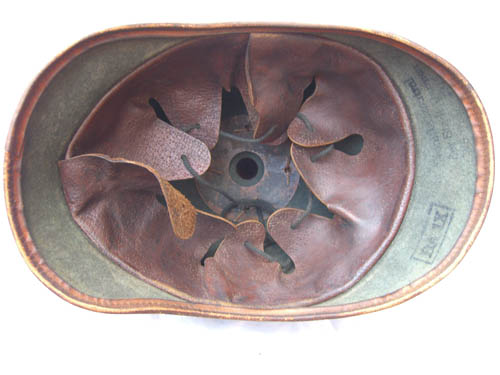 |
|
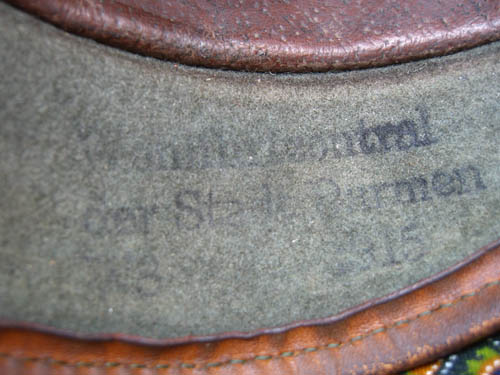 |
|
|
There have been changes to the marks and we are back to well-known fakes. |
|
 |
|
|
This helmet also was squishy. So these are examples of older helmets. Collectors might value seeing some of these characteristics. |
|
|
This article would not be possible without the kind contribution of pictures from a host of sources including the Trawnik, Francom, Booth, Braziel, and Chen collections.
|

